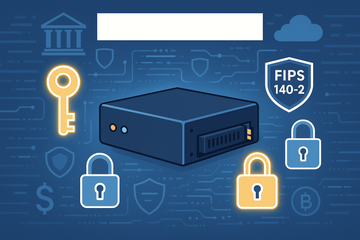Ever wonder what stands between your sensitive data and prying eyes in the vast digital universe? Let me tell you, it’s not just complex passwords or clever software. The real guardians working behind the scenes are often hardware security modules—better known in the biz as HSMs. Honestly, most folks outside cybersecurity circles haven’t heard much about HSMs, but once you get how crucial they are, you’ll see why banks, governments, and crypto nerds like to sing their praises.
So, What’s an HSM Anyway?
Picture this: a tamper-resistant black box that stubbornly refuses to spill its secrets, no matter what tricks or tools are thrown at it. That’s pretty much what an HSM is. Technically, it’s a dedicated hardware unit designed to safeguard and manage cryptographic keys, handle digital signatures, and keep your secrets safe from digital (and physical) thieves. Not only does it keep the keys hidden, but it also does all the cryptographic heavy lifting—encrypting, decrypting, signing, and authenticating—inside its protected shell. Think of it as the digital world’s equivalent of a locked vault with a built-in security team always on the lookout.
Why Are Crypto Keys Such a Big Deal?
Let’s break it down. In today’s high-speed, high-stakes world (okay, I promised not to use that phrase, but sometimes it fits!), cryptographic keys are the backbone of almost everything secure online. Your online banking, confidential work emails, and that NFT you bought last year—every one of them depends on cryptographic keys for trust. If those keys get stolen, it’s like losing the master key to your whole digital life. That’s why HSMs are such a big deal, especially for folks working with cryptocurrencies and hardware wallets like Trezor or Ledger.
How Do HSMs Actually Work?
HSMs are loaded with custom-designed chips (cryptoprocessors) that keep keys secure and perform cryptographic operations wholly within their own enclosure. Forget copying keys out to the cloud or letting software see them in memory. The hardware shields them from software bugs, malware, or even a rogue IT admin with too much access. Here’s what makes HSMs unique:
- Tamper Resistance: Some HSMs physically self-destruct if tampering is detected. Others lock you out instantly. You get the point—breaking in isn’t easy.
- Key Management: Everything from creation and rotation to backup and retirement happens under digital lock and key. Some models even use true random number generators to create keys that can’t be guessed.
- Certifications: Ever heard of FIPS 140-2 or Common Criteria? HSMs with these certifications are trusted even by governments and major enterprises.
Software Solutions: Are They Falling Short?
Now, you might be asking, 'Can't software do the same thing?' Fair question. Software key storage is convenient and cheap. But, like leaving your house key under the mat, it just isn’t wise if you’re guarding something really valuable (think customer credit cards, medical records, or a million bucks in Bitcoin). Malware, hackers, or slip-ups in cloud setups can all lead to catastrophic leaks. HSMs don’t just raise the security bar—they bolt it to the ground. If you’re dealing with serious security, the consensus is clear: go hardware or go home.
Where Do We See HSMs in Action—Real-World, Not Just Theory
Banks and payment processors rely on HSMs to authorize every transaction and generate payment cards. When you use your contactless card at a cafe, an HSM in the background secures your payment data. Government agencies use them to issue and manage digital IDs and passports. Even mobile network operators trust HSMs to protect the keys that secure conversations and verify devices.
And for the crypto heads—the hardware wallets most folks rave about, like Ledger and Trezor? They act like mini-HSMs for your pocket. They generate and store your wallet’s private keys offline, ensuring they never see the light (or threats) of your connected computer. That’s why seasoned crypto users won’t go anywhere without their trusty hardware wallet. Ironically, losing one is like misplacing Fort Knox in your jeans; there’s no password reset button here, folks.
Are HSMs Bulletproof? Let’s Get Real
Nothing’s ever perfect, right? While HSMs are as close to Fort Knox as digital security gets, they’re not entirely invincible. Skilled attackers might target supply chain weaknesses, slip in malicious code, or exploit out-of-date firmware. That’s why industry leaders keep firmware under lock and key, update regularly, and require authentication for nearly every action. Some clever criminals have even experimented with side-channel attacks that probe for telltale electrical signals (James Bond, eat your heart out). The best HSMs sport safeguards that notice suspicious behavior and, when all else fails, wipe their secrets before the crooks can get away with anything useful.
Cloud HSMs and the Future—Is The Box Moving Up?
You know how everything’s moving to the cloud? HSMs are, too. Cloud-based HSMs let organizations tap powerful secure modules on demand—often from giants like AWS or Azure. No more buying expensive hardware or wrangling with tricky integrations. Instead, you get virtual HSMs that stick to the same best-in-class security standards. The move brings some new headaches (like trusting a third party, or latency when you’re processing zillions of transactions). But it’s a sign of the times: agility and security don’t have to be at odds anymore.
One Last Thing: The Human Element
For all their tech wizardry, HSMs aren’t magic. Someone still has to set policy, manage updates, and decide who gets access. Human error or laziness—like skipping firmware updates—can trip things up fast. So, as much as we rely on hardware controls, they’re always part of a bigger, ongoing story about trust, vigilance, and, honestly, not cutting corners.
Final Word—Who Needs an HSM?
If you’re a casual user, a simple password manager or hardware wallet does the trick. But for organizations handling financial transactions, sensitive governmental data, or massive crypto holdings, hardware security modules are more than fancy gadgets—they’re the unsung heroes of digital trust.
And next time you hear somebody flippantly mention “military-grade” encryption, remember there’s usually an HSM lurking somewhere behind the scenes, keeping everyone honest. Maybe not the flashiest piece of technology, but sometimes that’s exactly what you want from your security solutions.











